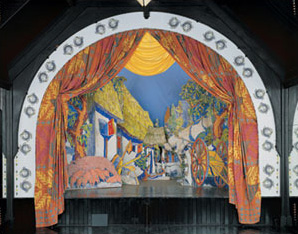 |
 |
In the fall of 1922, Léon Bakst (1866–1924), the avant-garde Russian set and costume designer who made his name working with Serge Diaghilev for the world renowned Ballets Russes, arrived in Baltimore for a six month stay at Evergreen House, the home of John Work and Alice Warder Garrett (see pages 152–153). Bakst had earned his reputation in Paris through the acclaimed ballet productions of Cléopâtre in 1909 and Schéhérezade in 1910. In 1922, Bakst removed to New York where he continued his work and exhibited his paintings, drawings, and textile designs. At the same time, the invitation to Baltimore was extended to him by Mrs. Garrett, his friend, patron, and agent in America, whom he met in Paris in 1914.
|
 |
|
|
|
Evergreen House carries the distinction of having the only extant private theatre with three original stage sets, and the original sketches for those sets, designed by artist Léon Bakst (1866–1924). |
Mrs. Garrett asked Bakst to decorate a private theatre in the north wing of her house, in a space previously used as a gymnasium and recently renovated by architect Laurence Hall Fowler. Bakst agreed to do this as a gift, in appreciation of her support during the eight years of their friendship. Mrs. Garrett, who studied voice and dance, used the setting to entertain her family and friends, in performances complete with music, costumes, and printed programs. Bakst approached the project much as he approached his work for the professional stage, successfully creating a stunning theatre with bold and striking décor reminiscent of the Oriental atmosphere of his famed ballets in Paris. Bakst produced original sketches and plans for the theatre, designed three stage sets, costumes, curtains, light fixtures, and a series of stencils in the art deco manner to decorate the theatre and its lobby. Passionate about his Russian heritage and inspired by Peasant Art in Russia, a book he found in the vast Garrett library, Bakst selected simple folk images of birds, flowers, and geometric patterns from carved wooden cake molds and embroidered bed curtains to transform the space.1 He designed stencils modeled after these images, and applied them with bold colors to the white plaster walls, archways, columns, and ceiling of the theatre and its lobby (above).
|
The Theatre, now referred to as the
 |
|
|
|
|
|
Bakst Theatre, opened with great fanfare to a select number of friends on May 4, 1923. The lobby alone garnered praise as “one of the most fascinating vistas imaginable” in a May 3 Baltimore News American preview article. The “Farm Scene” (left), also referred to as the “Irish Barnyard” or “The Rustic Mill,” was one of the sets designed by Bakst, and was used during opening night. As one of the performers for the evening, the costumed Mrs. Garrett, sitting in a swing hung from the rafters of the old gym, delivered a program of traditional Irish folk songs that included “Londonderry Air,” “My Handsome Winsome Johnny,” and “Moon Cradle.”
“Farm Scene” was recently reinstalled in the Theatre for the first time since Mrs. Garrett used it in the late 1920s. It and another stage set, “Chansons Orientales,” were conserved in 2002 by Sian Jones and Wendy Samet of Art Conservation and Technical Services, a project funded by the National Endowment for the Arts and the Richard C. von Hess Foundation. Conservation of these rare examples of Bakst’s work along with the third set, “Seville Street Scene,” conserved in 1992, allow the Theatre at Evergreen to tell the story of Bakst’s winter in Baltimore.
Evergreen House carries the distinction of having the only extant private theatre with three original stage sets, and the original sketches for those sets, designed by artist Léon Bakst (1866–1924). |
Jackie O’Regan is Curator at Evergreen House, Johns Hopkins University, Baltimore, where she co-curated with Cindy Kelly the exhibition, A Russian’s Winter in Baltimore: Léon Bakst at Evergreen, 1922–1923 (February 9–May 25, 2003).
|
|
|
Charles Holme, Peasant Art in Russia (New York: The Studio, Ltd., 1912), in the John Work Garrett Library of The Johns Hopkins University.
|
|
|